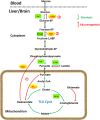Cerebral Gluconeogenesis and Diseases
- PMID: 28101056
- PMCID: PMC5209353
- DOI: 10.3389/fphar.2016.00521
Cerebral Gluconeogenesis and Diseases
Abstract
The gluconeogenesis pathway, which has been known to normally present in the liver, kidney, intestine, or muscle, has four irreversible steps catalyzed by the enzymes: pyruvate carboxylase, phosphoenolpyruvate carboxykinase, fructose 1,6-bisphosphatase, and glucose 6-phosphatase. Studies have also demonstrated evidence that gluconeogenesis exists in brain astrocytes but no convincing data have yet been found in neurons. Astrocytes exhibit significant 6-phosphofructo-2-kinase/fructose-2,6-bisphosphatase-3 activity, a key mechanism for regulating glycolysis and gluconeogenesis. Astrocytes are unique in that they use glycolysis to produce lactate, which is then shuttled into neurons and used as gluconeogenic precursors for reduction. This gluconeogenesis pathway found in astrocytes is becoming more recognized as an important alternative glucose source for neurons, specifically in ischemic stroke and brain tumor. Further studies are needed to discover how the gluconeogenesis pathway is controlled in the brain, which may lead to the development of therapeutic targets to control energy levels and cellular survival in ischemic stroke patients, or inhibit gluconeogenesis in brain tumors to promote malignant cell death and tumor regression. While there are extensive studies on the mechanisms of cerebral glycolysis in ischemic stroke and brain tumors, studies on cerebral gluconeogenesis are limited. Here, we review studies done to date regarding gluconeogenesis to evaluate whether this metabolic pathway is beneficial or detrimental to the brain under these pathological conditions.
Keywords: glioma; gluconeogenesis; glycolysis; lactate; metastatic breast cancer; pyruvate recycling; stroke; tumor-infiltrating lymphocytes.
Figures

Similar articles
-
Induction and suppression of the key enzymes of glycolysis and gluconeogenesis in isolated perfused rat liver in response to glucose, fructose and lactate.Biochem J. 1973 May;134(1):143-56. doi: 10.1042/bj1340143. Biochem J. 1973. PMID: 4353083 Free PMC article.
-
Influence of tamoxifen on gluconeogenesis and glycolysis in the perfused rat liver.Chem Biol Interact. 2011 Aug 15;193(1):22-33. doi: 10.1016/j.cbi.2011.04.010. Epub 2011 May 4. Chem Biol Interact. 2011. PMID: 21570382
-
Induction in primary culture of 'gluconeogenic' and 'glycolytic' hepatocytes resembling periportal and perivenous cells.Eur J Biochem. 1982 Aug;126(2):271-8. doi: 10.1111/j.1432-1033.1982.tb06775.x. Eur J Biochem. 1982. PMID: 6751822
-
The role of cyclic AMP in rapid and long-term regulation of gluconeogenesis and glycolysis.Adv Second Messenger Phosphoprotein Res. 1988;22:175-91. Adv Second Messenger Phosphoprotein Res. 1988. PMID: 2852023 Review.
-
Disorders of gluconeogenesis.J Inherit Metab Dis. 1996;19(4):470-7. doi: 10.1007/BF01799108. J Inherit Metab Dis. 1996. PMID: 8884571 Review.
Cited by
-
Neuroprotective Effects of Pharmacological Hypothermia on Hyperglycolysis and Gluconeogenesis in Rats after Ischemic Stroke.Biomolecules. 2022 Jun 19;12(6):851. doi: 10.3390/biom12060851. Biomolecules. 2022. PMID: 35740974 Free PMC article.
-
Metabolic perturbations after pediatric TBI: It's not just about glucose.Exp Neurol. 2019 Jun;316:74-84. doi: 10.1016/j.expneurol.2019.03.018. Epub 2019 Apr 3. Exp Neurol. 2019. PMID: 30951705 Free PMC article. Review.
-
Altered glucose metabolism and insulin resistance in cancer-induced cachexia: a sweet poison.Pharmacol Rep. 2021 Feb;73(1):17-30. doi: 10.1007/s43440-020-00179-y. Epub 2020 Nov 3. Pharmacol Rep. 2021. PMID: 33141425 Review.
-
High-intensity training on CREB activation for improving brain health: a narrative review of possible molecular talks.Front Endocrinol (Lausanne). 2025 Jan 20;15:1498495. doi: 10.3389/fendo.2024.1498495. eCollection 2024. Front Endocrinol (Lausanne). 2025. PMID: 39902166 Free PMC article. Review.
-
The neurovascular unit and systemic biology in stroke - implications for translation and treatment.Nat Rev Neurol. 2022 Oct;18(10):597-612. doi: 10.1038/s41582-022-00703-z. Epub 2022 Sep 9. Nat Rev Neurol. 2022. PMID: 36085420 Review.
References
Publication types
Grants and funding
LinkOut - more resources
Full Text Sources
Other Literature Sources

